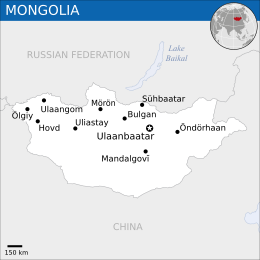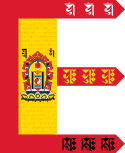Bogd Khanate of Mongolia (1911–1924): Difference between revisions
More languages
More actions
No edit summary Tag: Visual edit |
No edit summary Tag: Visual edit |
||
| Line 1: | Line 1: | ||
{{Infobox country|name=Bogd Khanate of Mongolia|native_name=ᠪᠣᠭᠳᠠ ᠬᠠᠭᠠᠨᠲᠤ ᠮᠣᠩᠭᠣᠯ ᠤᠯᠤᠰ<br>Богд хаант Монгол Улс|image_flag=Flag of Bogd Khanate.svg|image_coat=Bogd Khanate Emblem.svg|capital=Niislel Khüree|mode_of_production=[[Feudalism]]|government_type=[[Theocratic]] [[monarchy]]|leader_title1=Khan|leader_name1=[[Bogd Khan]]|life_span=1911–1924|common_languages=Mongolian}} | {{Infobox country|name=Bogd Khanate of Mongolia|native_name=ᠪᠣᠭᠳᠠ ᠬᠠᠭᠠᠨᠲᠤ ᠮᠣᠩᠭᠣᠯ ᠤᠯᠤᠰ<br>Богд хаант Монгол Улс|image_flag=Flag of Bogd Khanate.svg|image_coat=Bogd Khanate Emblem.svg|capital=Niislel Khüree|mode_of_production=[[Feudalism]]|government_type=[[Theocratic]] [[monarchy]]|leader_title1=Khan|leader_name1=[[Bogd Khan]]|life_span=1911–1924|image_map=Mongolia map.svg|map_width=260|common_languages=Mongolian}} | ||
The ''' | The '''Khanate of Mongolia''' was a theocratic feudal state that existed between the [[Mongolian Revolution of 1911|1911 national liberation revolution]] and the [[Mongolian People's Revolution|1921 socialist revolution]] in Mongolia. | ||
== Background == | == Background == | ||
Following the 1904–5 [[Russo-Japanese War]], [[Inner Mongolia Autonomous Region|Inner Mongolia]] fell under [[Empire of Japan (1868–1947)|Japan]]'s sphere of influence while Outer Mongolia fell under [[Russian Empire (1721–1917)|Russia]]'s influence. The Russian Empire sought to control Mongolia in order to gain an advantage against [[Imperialism|imperialist]] Japan. Between 1891 and 1908, Russian exports to Mongolia increased by 22% while Mongolian exports to Russia increased by 566%.<ref name=":0" /><sup>:232–3</sup> | Following the 1904–5 [[Russo-Japanese War]], [[Inner Mongolia Autonomous Region|Inner Mongolia]] fell under [[Empire of Japan (1868–1947)|Japan]]'s sphere of influence while Outer Mongolia fell under [[Russian Empire (1721–1917)|Russia]]'s influence. The Russian Empire sought to control Mongolia in order to gain an advantage against [[Imperialism|imperialist]] Japan. Between 1891 and 1908, Russian exports to Mongolia increased by 22% while Mongolian exports to Russia increased by 566%.<ref name=":0" /><sup>:232–3</sup> | ||
In early 1911, Colonel Tan from the declining [[Qing dynasty (1636–1912)|Qing dynasty]] arrived in Mongolia and ordered barracks to be built in Örgöö (now Ulaanbaatar). The Mongol nobility held a secret meeting in July planning to break away from the Qing and notified the Russian ambassador to Mongolia. In October, the collapsing Qing agreed not to do any reforms in Outer Mongolia without Russian approval.<ref name=":0">{{Citation|author=A. A. Guber, et al.|year=1973|title=History of the Mongolian People's Republic|title-url=https://archive.org/details/HistoryOfTheMPR/page/n116/mode/1up|chapter=The | In early 1911, Colonel Tan from the declining [[Qing dynasty (1636–1912)|Qing dynasty]] arrived in Mongolia and ordered barracks to be built in Örgöö (now Ulaanbaatar). The Mongol nobility held a secret meeting in July planning to break away from the Qing and notified the Russian ambassador to Mongolia. In October, the collapsing Qing agreed not to do any reforms in Outer Mongolia without Russian approval.<ref name=":0">{{Citation|author=A. A. Guber, et al.|year=1973|title=History of the Mongolian People's Republic|title-url=https://archive.org/details/HistoryOfTheMPR/page/n116/mode/1up|chapter=The National-Liberation Movement of the Mongolian People}}</ref><sup>:234–7</sup> | ||
== 1911 revolution == | == 1911 revolution == | ||
| Line 13: | Line 13: | ||
== Foreign relations == | == Foreign relations == | ||
In 1912 November, Russia signed a treaty with Mongolia giving Russian [[Bourgeoisie|capitalists]] unlimited rights to trade and travel in Mongolia with no [[Tariff|tariffs]]. The Bogd Khan sent the Dalai Lama [[Thubten Gyatso]] to Japan and requested a Japanese protectorate over Mongolia, which Japan refused in order to avoid angering Russia. In 1913 February, Mongolia formed a brigade of the Russian army with 1,900 soldiers. Mongolia tried to establish diplomatic relations with other imperialist countries but failed. Yuan Shikai's forces attacked Mongolia in early 1913 and made peace in November, recognizing Mongolia as autonomous but not fully independent. The Bogd Khan withdrew his troops from Inner Mongolia in 1913, and Russia withdrew its troops from Outer Mongolia in 1914.<ref name=":0" /><sup>:240–7</sup> | In 1912 November, Russia signed a treaty with Mongolia giving Russian [[Bourgeoisie|capitalists]] unlimited rights to trade and travel in Mongolia with no [[Tariff|tariffs]]. The Bogd Khan sent the Dalai Lama [[Thubten Gyatso]] to Japan and requested a Japanese protectorate over Mongolia, which Japan refused in order to avoid angering Russia. In 1913 February, Mongolia formed a brigade of the Russian army with 1,900 soldiers. Mongolia tried to establish diplomatic relations with other imperialist countries but failed. Yuan Shikai's forces attacked Mongolia in early 1913 and made peace in November, recognizing Mongolia as autonomous but not fully independent. The Bogd Khan withdrew his troops from Inner Mongolia in 1913, and Russia withdrew its troops from Outer Mongolia in 1914.<ref name=":0" /><sup>:240–7</sup> | ||
== Economy == | |||
Nobles (''khoshun dzasak'') had absolute power over their serfs (''arat''), who were divided into three categories: ''khamdjilga'', ''shabinars'', and ''albatu''.<ref name=":0" /><sup>:251</sup> | |||
== Government == | |||
The Bogd Khanate was an absolute monarchy with the Bogd Khan as head of church and state. In 1914, the Bogd Khan created two houses to advise him, but they had no power to make laws and could be dissolved at will. The upper house was made up of high-ranking feudal lords, and the lower house was made up of low-ranking lords and officials. The nobility and peasants were tried in separate courts as they had been under the Qing.<ref name=":0" /><sup>:250–1</sup> | |||
== References == | == References == | ||
Revision as of 18:57, 30 May 2024
| Bogd Khanate of Mongolia ᠪᠣᠭᠳᠠ ᠬᠠᠭᠠᠨᠲᠤ ᠮᠣᠩᠭᠣᠯ ᠤᠯᠤᠰ Богд хаант Монгол Улс | |
|---|---|
| 1911–1924 | |
 | |
| Capital | Niislel Khüree |
| Common languages | Mongolian |
| Dominant mode of production | Feudalism |
| Government | Theocratic monarchy |
• Khan | Bogd Khan |
The Khanate of Mongolia was a theocratic feudal state that existed between the 1911 national liberation revolution and the 1921 socialist revolution in Mongolia.
Background
Following the 1904–5 Russo-Japanese War, Inner Mongolia fell under Japan's sphere of influence while Outer Mongolia fell under Russia's influence. The Russian Empire sought to control Mongolia in order to gain an advantage against imperialist Japan. Between 1891 and 1908, Russian exports to Mongolia increased by 22% while Mongolian exports to Russia increased by 566%.[1]:232–3
In early 1911, Colonel Tan from the declining Qing dynasty arrived in Mongolia and ordered barracks to be built in Örgöö (now Ulaanbaatar). The Mongol nobility held a secret meeting in July planning to break away from the Qing and notified the Russian ambassador to Mongolia. In October, the collapsing Qing agreed not to do any reforms in Outer Mongolia without Russian approval.[1]:234–7
1911 revolution
Mongolia declared independence on 1911 December 1, and the Chinese garrison returned to China under the protection of Russian Cossacks. The Qing official in Khovd sealed himself inside a fort with many soldiers and supplies and requested reinforcements from Xinjiang, which Russia prevented from arriving. On 1912 August 6, the peasants stormed the fortress and destroyed debt records. After the Qing was overthrown, the feudal nobility led by the Bogd Khan took power. Yuan Shikai, the new ruler of China, refused to recognize Mongolia's independence.[1]:237–40
Foreign relations
In 1912 November, Russia signed a treaty with Mongolia giving Russian capitalists unlimited rights to trade and travel in Mongolia with no tariffs. The Bogd Khan sent the Dalai Lama Thubten Gyatso to Japan and requested a Japanese protectorate over Mongolia, which Japan refused in order to avoid angering Russia. In 1913 February, Mongolia formed a brigade of the Russian army with 1,900 soldiers. Mongolia tried to establish diplomatic relations with other imperialist countries but failed. Yuan Shikai's forces attacked Mongolia in early 1913 and made peace in November, recognizing Mongolia as autonomous but not fully independent. The Bogd Khan withdrew his troops from Inner Mongolia in 1913, and Russia withdrew its troops from Outer Mongolia in 1914.[1]:240–7
Economy
Nobles (khoshun dzasak) had absolute power over their serfs (arat), who were divided into three categories: khamdjilga, shabinars, and albatu.[1]:251
Government
The Bogd Khanate was an absolute monarchy with the Bogd Khan as head of church and state. In 1914, the Bogd Khan created two houses to advise him, but they had no power to make laws and could be dissolved at will. The upper house was made up of high-ranking feudal lords, and the lower house was made up of low-ranking lords and officials. The nobility and peasants were tried in separate courts as they had been under the Qing.[1]:250–1


